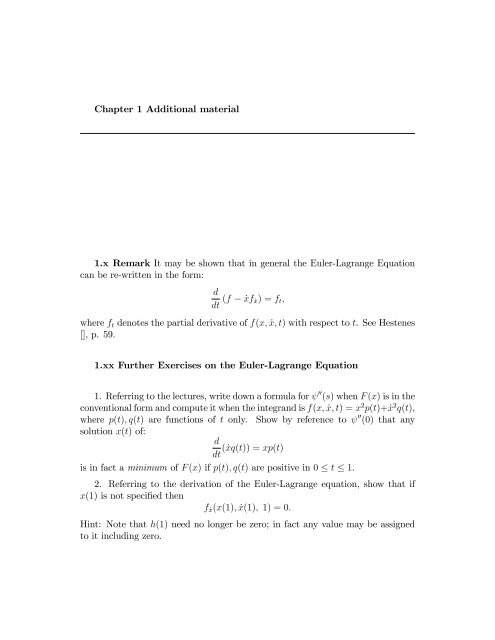Further Exercises on the Euler-Lagrange Equation
Further Exercises on the Euler-Lagrange Equation
Further Exercises on the Euler-Lagrange Equation
You also want an ePaper? Increase the reach of your titles
YUMPU automatically turns print PDFs into web optimized ePapers that Google loves.
Chapter 1 Additi<strong>on</strong>al material1.x Remark It may be shown that in general <strong>the</strong> <strong>Euler</strong>-<strong>Lagrange</strong> Equati<strong>on</strong>can be re-written in <strong>the</strong> form:ddt (f _xf _x) = f t ;where f t denotes <strong>the</strong> partial derivative of f(x; _x; t) with respect to t. See Hestenes[], p. 59.1.xx <str<strong>on</strong>g>Fur<strong>the</strong>r</str<strong>on</strong>g> <str<strong>on</strong>g>Exercises</str<strong>on</strong>g> <strong>on</strong> <strong>the</strong> <strong>Euler</strong>-<strong>Lagrange</strong> Equati<strong>on</strong>1. Referring to <strong>the</strong> lectures, write down a formula for 00 (s) when F (x) is in <strong>the</strong>c<strong>on</strong>venti<strong>on</strong>al form and compute it when <strong>the</strong> integrand is f(x; _x; t) = x 2 p(t)+ _x 2 q(t),where p(t); q(t) are functi<strong>on</strong>s of t <strong>on</strong>ly. Show by reference to 00 (0) that anysoluti<strong>on</strong> x(t) of:d( _xq(t)) = xp(t)dtis in fact a minimum of F (x) if p(t); q(t) are positive in 0 t 1.2. Referring to <strong>the</strong> derivati<strong>on</strong> of <strong>the</strong> <strong>Euler</strong>-<strong>Lagrange</strong> equati<strong>on</strong>, show that ifx(1) is not speci…ed <strong>the</strong>nf _x (x(1); _x(1); 1) = 0:Hint: Note that h(1) need no l<strong>on</strong>ger be zero; in fact any value may be assignedto it including zero.
3. Show that if x(0) and x(1) are not speci…ed <strong>the</strong>n for = 0 and = 1 wehave:f _x (x(); _x(); ) = 0:Use <strong>the</strong>se c<strong>on</strong>diti<strong>on</strong>s to …nd <strong>the</strong> particular functi<strong>on</strong> x(t) which minimises <strong>the</strong>integral:Z 10fx + _x + x _x + 1 2 _x2 g dtwhen <strong>the</strong> end-point values of x(t) are not speci…ed.4. Use <strong>the</strong> <strong>Lagrange</strong> Multiplier Method to solve:subject toand x(0) = x(1) = 0.min F (x) =Z 10Z 10x(t) 2 dt = 2_x(t) 2 dt5. Use <strong>the</strong> <strong>Lagrange</strong> Multiplier Method to solve:min F (x) =Z 10fx 2 + _x(t) 2 g dtsubject to Z 1x(t)e 2t dt = 10and x(0) = 1 and lim t!1 x(t) = 0. [Hint: Take <strong>the</strong> upper limit to be , solve,and <strong>the</strong>n take to <strong>the</strong> limit. See also <strong>the</strong> poscript secti<strong>on</strong> below.]6. Maximise over x(t) <strong>the</strong> expressi<strong>on</strong> R =20sin t x(t) dt subject to:Z =20x(t) dt = 0;Z =20t x(t) dt = 0;Z =20x(t) 2 dt = 1:Comment: This problem may be treated geometrically; it asks for a vector xof length 1 (in <strong>the</strong> appropriate norm jj:jj 2 ) perpendicular to <strong>the</strong> vectors u; v: <strong>the</strong>
c<strong>on</strong>stant functi<strong>on</strong> functi<strong>on</strong> u 1 and <strong>the</strong> functi<strong>on</strong> v t and with maximalprojecti<strong>on</strong> <strong>on</strong>to <strong>the</strong> vector w sin t. A geometric tool is provided by <strong>the</strong> Gram-Schmidt process, from where it is clear that x(t) needs to be an appropriate linearcombinati<strong>on</strong> of u; v; w. The same c<strong>on</strong>clusi<strong>on</strong> is drawn from <strong>the</strong> <strong>Euler</strong>-<strong>Lagrange</strong>equati<strong>on</strong>s, <strong>the</strong> appropriate scalars being <strong>Lagrange</strong> multipliers.7. Maximise <strong>the</strong> integral R +1x(t) log x(t) dt subject to:1Z +11x(t) dt = 1;Z +11t 2 x(t) dt = 2 :This is a problem similar to <strong>the</strong> last, but with c<strong>on</strong>necti<strong>on</strong>s with probability; it asksfor a probability distributi<strong>on</strong> x(t) of a random variable t, with <strong>the</strong> …rst c<strong>on</strong>straintbeing about its expectati<strong>on</strong> and <strong>the</strong> sec<strong>on</strong>d about its variance. [Hint: Refer to<strong>the</strong> de…niti<strong>on</strong> of <strong>the</strong> gamma functi<strong>on</strong>.]8. A country’s debt D t obeys <strong>the</strong> equati<strong>on</strong>:D 0 t = rD t + M tS twhere r is <strong>the</strong> bank rate, M t is <strong>the</strong> rate at which raw materials are imported andS t is <strong>the</strong> rate at which goods are exported. In order to clear an initial debt ofD 0 by time T precisely <strong>the</strong> government proposes to maximize producti<strong>on</strong> over <strong>the</strong>time range [0; T ] <strong>on</strong> <strong>the</strong> assumpti<strong>on</strong> that <strong>the</strong> output is always sold. Assuming aproducti<strong>on</strong> functi<strong>on</strong> S t = a p M t with a > 0 and writing x t = M t S t = S 2 t =a 2 S tshow that <strong>the</strong> government’s problem amounts to maximising:subject toZ T0Z T0pa2 + 4x t dte rt x t dt = D 0 ;where it is assumed that x 0 = 0. Find <strong>the</strong> extremal curve for <strong>the</strong> problem andshow that <strong>the</strong> plan is feasible if and <strong>on</strong>ly if:D 0 = a2 (1 cosh rT ):2r
[Hint: Find S t in terms of x t and integrate <strong>the</strong> debt equati<strong>on</strong>.]9. Maximise R 1f(t)p x(t) dt subject to R 1x(t) dt = c.010. Maximise R 10 f(t)x(t) dt subject to R 1x(t) dt = c where 1 .0011. For <strong>the</strong> problem:subject tominZ T0(x 2 + _x 2 ) dtx(0) = c; x(T ) = 0;<strong>the</strong> trajectory is known to be of <strong>the</strong> formshow thatx T (t) = Ae t + Be t ;lim A T = 0:T !1Show also that, pointwise lim T !1 x T (t) = ce t . Interpreting x T (t) = x T (T ) fort > T , verify that <strong>the</strong> limit is uniform.12. For <strong>the</strong> problem:min 1 2subject to x(0) = 1; x(1) = 0 andZ 10Z 10(x 2 + _x 2 ) dtxe 2t dt = 1show that <strong>the</strong> optimal curve is x = 9e t 8e 2t .13. For <strong>the</strong> problem:minZ 20f r 2 + 2 _r 2 g 1=2 d
where = (1 =r) 1 and is a c<strong>on</strong>stant, while _r here denotes dr=d, show that<strong>the</strong> <strong>Euler</strong>-<strong>Lagrange</strong> Equati<strong>on</strong> reduces to <strong>the</strong> (Ricatti) equati<strong>on</strong>:where u = 1=r.14. Solve <strong>the</strong> problem:minsubject to x(0) = 0; x(1) = 1.d 2 ud 2 + u = 3 2 u2 ;Z 10(t 2 + x 2 + _x 2 ) dt1.xxx Postscript: Dealing with in…nite horiz<strong>on</strong> problemsRecall problem 5 in <strong>the</strong> last secti<strong>on</strong>; <strong>the</strong> trajectory is found to be of <strong>the</strong>form:x(t) = Ae t + Be t + Ce t + De t ;where > > 0 and 6= . The problem speci…ed x(0); _x(0) as given andrequired lim t!1 x(t) = 0 and lim t!1 _x(t) = 0. It is natural to set A = B = 0and c<strong>on</strong>tinue with <strong>the</strong> problem. In this note we justify <strong>the</strong> procedure. It willbe clear that <strong>the</strong> method extends bey<strong>on</strong>d just two exp<strong>on</strong>entially growing terms.We take our terminal c<strong>on</strong>diti<strong>on</strong>s in <strong>the</strong> form:x(T ) = _x(T ) = 0:This yields <strong>the</strong> following matrix equati<strong>on</strong> of boundary c<strong>on</strong>diti<strong>on</strong>s:23 2 3 2 31 1 1 1 A x(0)6 7 6 B74 e T e T e T e T 5 4 C 5 = 6 _x(0)74 0 5 :e T e T e T e T D 0By Cramer’s rule we obtain:A T = linear combinati<strong>on</strong>s of:(e( )T ; e (+)T ; 1);1( ) 2 e (+)T + :::
The numerator is obvious from <strong>the</strong> expansi<strong>on</strong> by <strong>the</strong> …rst column; <strong>the</strong> criticalterm of <strong>the</strong> denominator comes from <strong>the</strong> bottom row, corner and adjacent termboth of which create <strong>the</strong> appropriate term by multiplicati<strong>on</strong> with <strong>the</strong> top rightsubdeterminant of size 2. It now follows thatSimilarly,lim A T = 0:T !1and againB T = linear combinati<strong>on</strong>s of:(e( )T ; e (+)T ; 1);1( ) 2 e (+)T + :::lim B T = 0:T !1We c<strong>on</strong>sider a similar problem in <strong>the</strong> <str<strong>on</strong>g>Exercises</str<strong>on</strong>g> (11?): Exercise:For <strong>the</strong>problem:subject toZ T0minZ T<strong>the</strong> trajectory is known to be of <strong>the</strong> formshow that0(x 2 + _x 2 ) dtxe 2t dt = 1 and x(0) = 1; x(T ) = 0;x(t) = Ae t + Be t + Ce 2t ;lim A T = 0:T !1Soluti<strong>on</strong>: The two boundary c<strong>on</strong>diti<strong>on</strong>s and <strong>the</strong> c<strong>on</strong>straint equati<strong>on</strong> lead to <strong>the</strong>matrix equati<strong>on</strong>:21 1 14 e T e T e 2T1 e T 1(1 e 3T 1) 3 4 e 4T )3 25 4ABC325 = 410135 :
The matrix has determinant with dominant term e T 141= 1 3 12 eT , soA = A T = linear combinati<strong>on</strong>s of:(e T ; e 2T ; e T ; e 3T ; e 4T ; e 5T ; 1)112 eT + :::! 0:A similar calculati<strong>on</strong> yieldsB T = e T ( 1 4! 3 12 = 9;41) linear combinati<strong>on</strong>s of:(e T ; e 2T ; e T ; e 3T ; e 4T ; e 5T ; 1)112 eT + :::but it is easier to set A = 0, now that that has beeen justi…ed, and to use <strong>the</strong>initial c<strong>on</strong>diti<strong>on</strong> and <strong>the</strong> c<strong>on</strong>straint equati<strong>on</strong> (to 1).
















